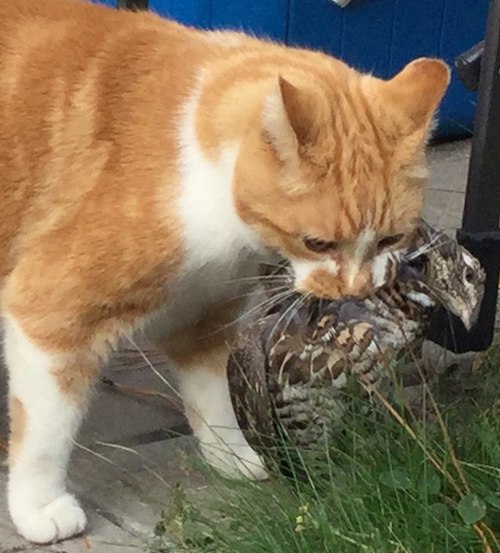Guest Blogger Grumpy Old Birder
Cats are one of the most popular pets in the world, but they are natural born killers and their impact on wild bird populations cannot be denied; it has been a subject of debate for many years. While cats are beloved by their owners, they are also natural predators that have a significant impact on the environment. In this article, we will explore the impact of cats on wild bird populations. It is estimated that cats in the United States alone kill between 1.3 and 4 billion birds each year. This number is staggering and has significant implications for the environment. It is estimated that cats have the biggest impact on bird populations, more even than disease or natural predation.
Cats are far from the innocent pets their owners believe… they have been responsible for extinctions. In fact, one cat was responsible for an extinction all by itself. St Stephen’s Island off mainland New Zealand was home to several endemic species. The St Stephen’s Island Wren was only known to science because the lighthouse keeper’s cat brought home one it had killed. Having no natural predators the wren had lost the ability to fly and lived, nested and fed on the ground. Over the next few years this one cat killed every single one of the hapless birds, so they are now gone forever!
What birds do cats kill most often?
The impact of cats on wild bird populations is particularly acute for certain species. For example, ground-nesting birds in North America like quail, sparrows, and plovers are particularly vulnerable to predation by cats. In the UK ground nesters are vulnerable too, but also many species that feed on the ground such as thrushes. Many other species are at risk including waterfowl, and shorebirds – it’s not just our common garden visitors that suffer.

Cats impact bird populations in several ways. The most obvious way is through predation. When cats hunt birds, they not only kill the individual bird but obviously, by doing so, reduce the overall population. Cats are effective hunters, and where they roam free they are responsible for the deaths of millions of birds each year.
Moreover, cats scare birds away from feeding and their other natural habits. The presence of a cat will cause alarm even when they fail to capture prey.
In addition to their impact on bird populations, cats can also have a significant impact on other wildlife. For example, cats can prey on small mammals, reptiles, and amphibians. This can have a significant impact on the overall ecology of an area. Whether it is the frogs and newts in your garden pond, or the local shrew population, they are impacted by domestic cats.
Keep Cats Indoors
Most cat owners mistakenly believe their moggies to be an exception to the predator rules. As they never see what has been killed by their pet they tell everyone that their cat never kills. Studies have shown that cat’s rarely bring home what they kill, and those that do present their owners with their ‘prizes’ only turn up with a tiny percentage of their kills.
There are several ways that we can mitigate the impact of cats on wild bird populations. The most effective of ways is to keep cats indoors. This not only protects birds but also keeps cats safe from other dangers like disease, road traffic and predators. The practice of letting cats roam free all night is unique to them, no other pet is treated this way. Indoor cats are safe and content and cannot kill birds.
Another way to reduce the impact of cats on bird populations is through the use of cat collars that contain bells. Bells can alert birds to the presence of cats, giving them a chance to escape. However, it is important to note that bells are not foolproof and may not work for all birds.
In some countries, particularly the USA there are very large populations of feral cats. Roaming and free to breed they displace other predators and upset the natural order in the environment. Some communities have implemented trap-neuter-return programs. These programs capture feral cats, sterilize them, and then release them back into the wild. This can help to reduce the overall population of cats in an area in the long-term, which may in turn reduce their impact on bird populations. However, it would be far more effective not to return them to the wild. This appeasement for cat lovers is, of course, a direct affront to those who love the creatures that cats kill. In environmental terms it cannot be justified. No other pets are given immunity – dogs are impounded for example, unless under the direct control of their owners.
In conclusion, while cats are beloved pets, they also have a devastating impact on wild bird populations. While it is not possible to completely eliminate the impact of cats on birds, there are steps that can and should be taken to mitigate their impact. By keeping cats indoors, using collars with bells, and culling feral populations, we can help to protect wild bird populations while still enjoying the companionship of our feline friends.
As a lover of the natural world I assert the rights of wild animals in their natural habitat as far more just than giving rights to animals that are not native and are kept in far larger numbers that any naturally occurring population. Cat owners must start taking responsibility for the damage caused by the practice of allowing their pets to roam free especially at night.
